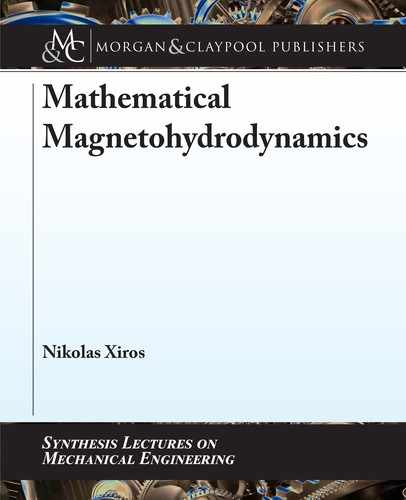
66 6. PLASMA BOUNDARY
6.5 COLLISIONAL SHEATH
At sufficiently high pressure, i.e., typically at pressures around 1 Pa or higher, collisions in the
sheath have to be taken into account. is becomes necessary in particular in case of high bias,
when the sheath thickness becomes large.
If no ions are generated or lost in the sheath, flux conservation (Eq. (6.33)) is still valid.
Also, charge-transfer collisions do not change the number of ions, although they might remove
the complete momentum from individual ions. However, the ions are no longer accelerated
throughout the sheath, but attain a stationary drift velocity
i
.x/ D
i
E.x/: (6.41)
We first consider the case with a constant mean free path length throughout the sheath.
en, with Eq. (5.4),
D
e
m
i
c
D
e
c
m
i
i
.x/
(6.42)
and
i
.x/ D
s
e
c
m
i
E.x/: (6.43)
With the same procedure as for Eq. (6.38) the result becomes
j
B
D
2
3
5
3
3=2
"
0
e
c
m
i
1=2
V
3=2
0
x
5=2
s
: (6.44)
Apart from a constant factor, this is different from the Child-Langmuir formula by the
factor .
c
=x
s
/
1=2
, which is small compared to one if an ion traveling through the sheath suffers
many collisions. At constant flux, the sheath thickness becomes correspondingly smaller than in
the Child-Langmuir collisionless case.
For the evaluation of the energy distribution of ions arriving at the negatively biased elec-
trode, we consider the special case of charge transfer collisions according to Davis and Vander-
slice. In particular in atomic gases such as Ar, symmetric charge transfer collisions exhibit a very
large cross section (see Section 2.7).
In Fig. 6.5, where the potential at the electrode has been arbitrarily set to 0, ions starting
at the plasma boundary are allowed to collide at any position x in the sheath. When collisions
are dominant, the ions establish a drift velocity (Eq. (6.43)) so that the density is constant within
most of the sheath. erefore, the electric field and the electrostatic potential vary linearly and
quadratically with the distance, respectively. With the correct boundary conditions,
x D x
s
2
4
1
s
1
V .x/
V
0
3
5
; (6.45)

6.5. COLLISIONAL SHEATH 67
dx
0 x
s
x
Cathode Negative
Glow
Figure 6.5: Cathode sheath geometry for the treatment of collisions of ions with neutral gas
particles.
where V
0
>> kT
e
is the applied voltage.
Charge transfer collisions leave the flux of ions unchanged. Within a slab of thickness dx
in the sheath, the number of charge transfer collisions per unit area is
d P
ct
D
j
i
ct
dx; (6.46)
where j
i
is the ion flux and
ct
the mean free path length between charge transfer collisions. e
probability, that ions generated within dx reach the cathode without any further charge transfer
collisions, is exp.x=
ct
/. erefore, the flux of ions arriving from dx at the cathode is
dj
i
.x/ D
j
i
ct
exp
x
ct
dx: (6.47)
(It should be noted that integration of Eq. (6.46) yields consistently the total ion flux provided
the mean free path length is small compared to the sheath thickness.) Via Eq. (6.45), the start
depth x corresponds to a potential difference V .x/. e ions resulting from charge transfer start
with thermal energy close to zero, so that V .x/ corresponds to the ion energy E
i
D eV.x/ at the
cathode. e ion energy distribution at the cathode then results as
f .E
i
/ D
1
j
i
dj
i
.E
i
/
dE
i
D
1
ej
i
dx
dV
dj
i
.x/
dx
: (6.48)
..................Content has been hidden....................
You can't read the all page of ebook, please click here login for view all page.
